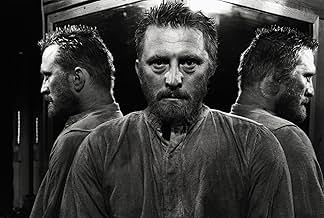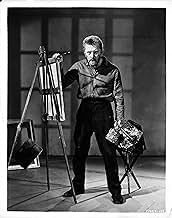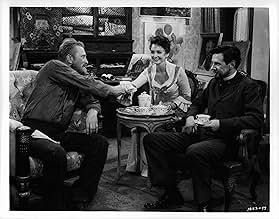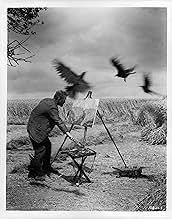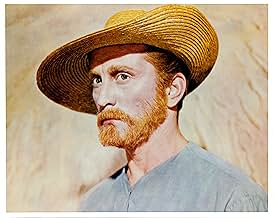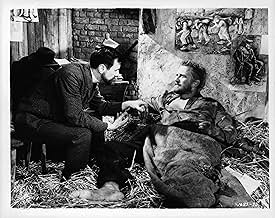VALUTAZIONE IMDb
7,3/10
12.922
LA TUA VALUTAZIONE
La vita straordinaria di un artista brillante ma tormentato: Vincent van Gogh.La vita straordinaria di un artista brillante ma tormentato: Vincent van Gogh.La vita straordinaria di un artista brillante ma tormentato: Vincent van Gogh.
- Regia
- Sceneggiatura
- Star
- Vincitore di 1 Oscar
- 4 vittorie e 6 candidature totali
Recensioni in evidenza
Not only does KIRK DOUGLAS bear a remarkable resemblance to the real Vincent Van Gogh, but he gives a deeply felt, bigger than life performance in the role of a lifetime, fully deserving his Academy Award nomination.
The letterbox version on TCM doesn't do justice to the film's brilliant color photography, deliberately muted for the early coal mining scenes but crisp and clear when it comes to Van Gogh's now famous paintings. I haven't seen the DVD version, but I hope it's considerably better than the print showing on cable.
At any rate, it's tremendously well done--the entire look of the production creating the sense of time and authentic atmosphere and actually filmed on the actual location sites with an impressive cast of villagers and supporting actors. PAMELA BROWN, NIALL MacGINNIS (as The Postman), and most of all, JAMES DONALD as brother Theo, who nurtures his brother and supports him financially but is unable to sell any of his paintings--except one.
It's a fine recreation of the Irving Stone novel and Douglas immerses himself in the character of Van Gogh, much the way ANTHONY QUINN does as Gauguin. Quinn's stormy, tempestuous relationship with Douglas provides some electric moments of conflict.
The score by Miklos Rozsa accents the drama at every turn, slashing at the drama the way Van Gogh slashed at his canvas with thick brush strokes. It's starkly dramatic without ever being overbearing.
Vincent Minnelli's direction is above reproach. A finer tribute to the tormented artist could not be imagined with so many of his canvases shown on screen in impressive close-ups.
The letterbox version on TCM doesn't do justice to the film's brilliant color photography, deliberately muted for the early coal mining scenes but crisp and clear when it comes to Van Gogh's now famous paintings. I haven't seen the DVD version, but I hope it's considerably better than the print showing on cable.
At any rate, it's tremendously well done--the entire look of the production creating the sense of time and authentic atmosphere and actually filmed on the actual location sites with an impressive cast of villagers and supporting actors. PAMELA BROWN, NIALL MacGINNIS (as The Postman), and most of all, JAMES DONALD as brother Theo, who nurtures his brother and supports him financially but is unable to sell any of his paintings--except one.
It's a fine recreation of the Irving Stone novel and Douglas immerses himself in the character of Van Gogh, much the way ANTHONY QUINN does as Gauguin. Quinn's stormy, tempestuous relationship with Douglas provides some electric moments of conflict.
The score by Miklos Rozsa accents the drama at every turn, slashing at the drama the way Van Gogh slashed at his canvas with thick brush strokes. It's starkly dramatic without ever being overbearing.
Vincent Minnelli's direction is above reproach. A finer tribute to the tormented artist could not be imagined with so many of his canvases shown on screen in impressive close-ups.
Kirk Douglas is Vincent Van Gogh in "Lust for Life," directed by Vincent Minnelli and also starring Anthony Quinn as Gaugin (Oscar winner for his performance), and James Donal as Van Gogh's brother Theo.
This film is actually based on the Irving Stone novel and while it leaves out parts of Van Gogh's life, it does seem to hit the high points. A sensitive man with a spiritual sense of life, Van Gogh seeks from the beginning to express God in some way and to give something to the world. He is unsuccessful as a minister and eventually takes up painting, supported by his loving brother Theo. Basically he lives somewhere until whomever he's living with gets sick of him and throws him out. He is a terribly lonely man, but he has an intensity that is almost frightening to people. At one point, he takes up with a sometime prostitute with a baby - she eventually leaves. In actual fact, when Van Gogh met this woman, named Sien, she was pregnant with a second child, who grew up believing Van Gogh was his father. Sien some 20+ years later commits suicide.
Van Gogh establishes a friendship with Gaugin and has dreams of an artist colony, but his relationship with Gaugin, as with everyone but his brother, ends terribly when he stalks Gaugin with an open straight razor, later cutting off part of his own ear. It is evident from the film that whatever Van Gogh's mental problem was (and there are many theories, from bipolar, to epilepsy, to schizophrenia), it worsened as time went on, as did his physical condition. He would often buy paints rather than eat and would work ceaselessly.
Van Gogh only sold one painting in his lifetime - however, what the film does not show is that, had he chosen to live, he was on the brink of being recognized for his work. His paintings had started being exhibited and appreciated and began to sell shortly after his death. What also isn't in the film is that his brother died shortly after Van Gogh did. It was Theo's widow who carried on the work that would be involved with Van Gogh's vast collection.
The film reduced me to tears - indeed, the song that says "they should have told you, Vincent, the world was never meant for one as beautiful as you" was certainly true. The only person who ever "got" Vincent was his brother.
As for the performances, Kirk Douglas makes a brilliant Van Gogh. Michael Douglas once said his father isn't considered a great actor because the style back then in the types of roles he played has changed. It's true - seen today, Douglas' work seems too intense at times, too big, too over the top in these times of acting so naturally as to almost be boring. However, I believe that Van Gogh must have been like the Douglas characterization. He obviously drove people away in large masses, and Douglas captured that passion, drive, and overeagerness perfectly. As Theo, James Donal is perfect as the calm one in the family. Anthony Quinn has a short but memorable role as the flamboyant Gaugin. He's wonderful - arrogant, opinionated, temperamental, with a bad temper, and Quinn plays him as an artist without the soul of Van Gogh. But who, after all, had the soul of Van Gogh? Vincent Minnelli lovingly directed this film and it definitely has his wonderful attention to detail, flow, and artistic touch. And the paintings are breathtaking. A beautiful film that will stay with you for a long time, and you'll never see "Starry Night" in the same way again.
This film is actually based on the Irving Stone novel and while it leaves out parts of Van Gogh's life, it does seem to hit the high points. A sensitive man with a spiritual sense of life, Van Gogh seeks from the beginning to express God in some way and to give something to the world. He is unsuccessful as a minister and eventually takes up painting, supported by his loving brother Theo. Basically he lives somewhere until whomever he's living with gets sick of him and throws him out. He is a terribly lonely man, but he has an intensity that is almost frightening to people. At one point, he takes up with a sometime prostitute with a baby - she eventually leaves. In actual fact, when Van Gogh met this woman, named Sien, she was pregnant with a second child, who grew up believing Van Gogh was his father. Sien some 20+ years later commits suicide.
Van Gogh establishes a friendship with Gaugin and has dreams of an artist colony, but his relationship with Gaugin, as with everyone but his brother, ends terribly when he stalks Gaugin with an open straight razor, later cutting off part of his own ear. It is evident from the film that whatever Van Gogh's mental problem was (and there are many theories, from bipolar, to epilepsy, to schizophrenia), it worsened as time went on, as did his physical condition. He would often buy paints rather than eat and would work ceaselessly.
Van Gogh only sold one painting in his lifetime - however, what the film does not show is that, had he chosen to live, he was on the brink of being recognized for his work. His paintings had started being exhibited and appreciated and began to sell shortly after his death. What also isn't in the film is that his brother died shortly after Van Gogh did. It was Theo's widow who carried on the work that would be involved with Van Gogh's vast collection.
The film reduced me to tears - indeed, the song that says "they should have told you, Vincent, the world was never meant for one as beautiful as you" was certainly true. The only person who ever "got" Vincent was his brother.
As for the performances, Kirk Douglas makes a brilliant Van Gogh. Michael Douglas once said his father isn't considered a great actor because the style back then in the types of roles he played has changed. It's true - seen today, Douglas' work seems too intense at times, too big, too over the top in these times of acting so naturally as to almost be boring. However, I believe that Van Gogh must have been like the Douglas characterization. He obviously drove people away in large masses, and Douglas captured that passion, drive, and overeagerness perfectly. As Theo, James Donal is perfect as the calm one in the family. Anthony Quinn has a short but memorable role as the flamboyant Gaugin. He's wonderful - arrogant, opinionated, temperamental, with a bad temper, and Quinn plays him as an artist without the soul of Van Gogh. But who, after all, had the soul of Van Gogh? Vincent Minnelli lovingly directed this film and it definitely has his wonderful attention to detail, flow, and artistic touch. And the paintings are breathtaking. A beautiful film that will stay with you for a long time, and you'll never see "Starry Night" in the same way again.
This is one of my favorite films. It deeply touched me. It's in my top 20 for sure. Maybe top 10. The acting, directing, and production are all about as good as it gets. It's a shame Kirk Douglas didn't win the best actor Oscar. I think it's his finest performance. I can't think of a single bad thing to say about this great movie. It's a vivid (and accurate) tribute to the immortal Vincent.
When I hear the name Vincente Minnelli certain scenes pop up on my inner screeningroom: A tracking shot at the fair (Some came running), the low tracking zoom towards Douglas and Turner at the pool (Bad and the Beautiful), snowmen (Meet me in St Louis) and the agony in Douglas's face in "Lust for life"; in fact as soon as his redbearded agonized face pops up, all the other movies fade away and "Lust for life" takes over my inner screening room.
But apart from being my favorite Minnelli movie, its a movie that more than any other shows his genius in use of colors; every scene is composed in breathtaking technicolor with the deepest respect for Van Gogh's own use of color, and Douglas's acting is filled with the same agony and passion as the strokes of Van Gogh's brush. As the other great movies who uses color to its fullest (Wizard of Oz, Black Narcissus, Ten Commandments), the simularities between the director and the painter is obvious. Hence, Minnelli's struggle for "painting" the scenes with the richness of technicolor becomes an echo of Van Gogh. It also reads as a textbook in composition from Steinberg's Dead Space to Eisenstein's juxtapositions. In all, Minnelli is of great skill and uses it to the fullest.
The story, which focuses on the struggle for a new way of expression, is tame at times and the acting (apart from Douglas) seems static most of the times, but the tortured face and body of Douglas and the use of color makes this one of the greatest achievements in MGM's history and one of the best movies Minnelli ever made.
But apart from being my favorite Minnelli movie, its a movie that more than any other shows his genius in use of colors; every scene is composed in breathtaking technicolor with the deepest respect for Van Gogh's own use of color, and Douglas's acting is filled with the same agony and passion as the strokes of Van Gogh's brush. As the other great movies who uses color to its fullest (Wizard of Oz, Black Narcissus, Ten Commandments), the simularities between the director and the painter is obvious. Hence, Minnelli's struggle for "painting" the scenes with the richness of technicolor becomes an echo of Van Gogh. It also reads as a textbook in composition from Steinberg's Dead Space to Eisenstein's juxtapositions. In all, Minnelli is of great skill and uses it to the fullest.
The story, which focuses on the struggle for a new way of expression, is tame at times and the acting (apart from Douglas) seems static most of the times, but the tortured face and body of Douglas and the use of color makes this one of the greatest achievements in MGM's history and one of the best movies Minnelli ever made.
Irving Stone wrote his book 'Lust for Life' in 1934 and MGM obtained the film rights to it in 1946, long before there was any intention to create this film. Biographical films about the lives of artists were not regarded as likely to be financially viable, and at the time Van Gogh, who had only sold one painting in his lifetime, was not really well known to the public or regarded as the most promising subject for such a film. This changed following a very successful exhibition of his works in 1955 and MGM decided to commission Minnelli to direct the film for them, but they had little time left to create it as their film rights to the book expired at the end of 1955. This greatly complicated the production. For example, rights to create still reproductions of almost 200 of Van Gogh's works for this film had to be negotiated with all the museums, galleries and private collectors world-wide who owned them, the pictures then had to be copied by special still cameras requiring only low illumination levels, and printed as large transparencies that could be back-lit for filming in any scenes where they were visible. Minnelli was a good choice as Director - previously a stage designer he was known for artistic sensibilities and an eye for colour. In his memoirs Minnelli reports two major battles with the studio moguls, one he won - the other he lost. Minnelli knew the Metrocolor process used at MGM generated saturated colours which would be too garish for this film. He had recently finished filming Brigadoon using Anscocolor stock and insisted this was what was needed, but Anscocolor cine stock had just been discontinued. MGM eventually agreed to buy up the last 300,000 feet of unused Anscocolor stock available, and to set up a laboratory in which it could be processed. Minnelli also bitterly opposed working in CinemaScope format, claiming the large aspect ratio was incompatible with most paintings, and would also spoil the intimacy of many of the scenes to be filmed; but he was over-ruled on this.
Half a century later we are in a position to appreciate how right he was over both these issues. Like most viewers my first reactions to a film I am watching usually relate to the quality of the film-script, the direction and the acting. If these are acceptable I know I am likely to feel that I have seen a very good film. But film stock remains very important - as a still photographer myself I am well aware of the need to evaluate whether a particular shot should be made on, for example, Fuji's Sensia, Astia or Velvia emulsions - the wrong choice usually destroys the effect the photographer is striving for. It is the same with movies - I can recall just four films ('The Riddle of the Sands',' Laura, les Ombres de l'Ete', 'Black Narcissus' and 'Lust for Life') where one of my first reactions has been admiration for the atmospheric qualities and colour rendering of the photography. There may have been others but such films are certainly not very numerous. Although the opening credits of L4L still attribute the colour to Metrocolor, this film could not have succeeded as it did if MGM had been unable to obtain the Ansco stock that was actually used. As for aspect ratio, we have only to compare the VHS version with the new widescreen DVD to confirm that Minnelli's vision was correct (and this is of course after he did everything possible to utilise sequences which take maximum advantage of the widescreen presentation that he was forced to adopt.)
The film-script has been criticised for inaccuracies in Van Gogh's life as shown (unfairly as it is based on Irving Stone's book, which is normally classed as a novel rather than a biography. MGM might have done better to write an independent film-script and present their film as a biography- not as a film of a novel. What probably prevented this was recognition that they would then be responsible for any errors.) As written it is a very powerful depiction of the gradually increasing intensity of Van Gogh's commitment to his art, which increasingly became the only significant driving force in everything he did. The two hour overall running time is just about right - the emotional impact of watching the gradual disintegration of Van Gogh's personality might have become quite distressing for some viewers if the film has been a great deal longer.
The acting is exceptional. Kirk Douglas, a remarkable look-alike to extant pictures of Van Gogh, put everything into his effort to create a believable picture of a man with an increasingly fanatical drive which eventually overwhelmed him. It earned him an Oscar nomination, but not an award. This, I feel, was not his fault - Van Gogh was too insecure to interact normally with others and this would have showed in his whole bearing, something an individual as secure and stable as Kirk could not easily emulate. An actor is by nature an extreme extrovert and trying to take the part of an introvert is very difficult - when the introvert is both fanatical and unbalanced it probably becomes impossible. This makes it hard to become involved with Kirk's portrayal of the role in the same way that one would have done with Van Gogh himself. Anthony Quinn's Best Supporting Actor Oscar award for his role as Paul Gauguin was well deserved. There were also memorable performances by James Donald as Theo and Pamela Brown as Christine. Theo's anguish in the deathbed sequence came over very effectively. The direction and camera work, although not faultless, were both of an extremely high standard. All in all, anyone interested either in modern painting or in the lives of modern painters will find this a most rewarding film to watch.
Half a century later we are in a position to appreciate how right he was over both these issues. Like most viewers my first reactions to a film I am watching usually relate to the quality of the film-script, the direction and the acting. If these are acceptable I know I am likely to feel that I have seen a very good film. But film stock remains very important - as a still photographer myself I am well aware of the need to evaluate whether a particular shot should be made on, for example, Fuji's Sensia, Astia or Velvia emulsions - the wrong choice usually destroys the effect the photographer is striving for. It is the same with movies - I can recall just four films ('The Riddle of the Sands',' Laura, les Ombres de l'Ete', 'Black Narcissus' and 'Lust for Life') where one of my first reactions has been admiration for the atmospheric qualities and colour rendering of the photography. There may have been others but such films are certainly not very numerous. Although the opening credits of L4L still attribute the colour to Metrocolor, this film could not have succeeded as it did if MGM had been unable to obtain the Ansco stock that was actually used. As for aspect ratio, we have only to compare the VHS version with the new widescreen DVD to confirm that Minnelli's vision was correct (and this is of course after he did everything possible to utilise sequences which take maximum advantage of the widescreen presentation that he was forced to adopt.)
The film-script has been criticised for inaccuracies in Van Gogh's life as shown (unfairly as it is based on Irving Stone's book, which is normally classed as a novel rather than a biography. MGM might have done better to write an independent film-script and present their film as a biography- not as a film of a novel. What probably prevented this was recognition that they would then be responsible for any errors.) As written it is a very powerful depiction of the gradually increasing intensity of Van Gogh's commitment to his art, which increasingly became the only significant driving force in everything he did. The two hour overall running time is just about right - the emotional impact of watching the gradual disintegration of Van Gogh's personality might have become quite distressing for some viewers if the film has been a great deal longer.
The acting is exceptional. Kirk Douglas, a remarkable look-alike to extant pictures of Van Gogh, put everything into his effort to create a believable picture of a man with an increasingly fanatical drive which eventually overwhelmed him. It earned him an Oscar nomination, but not an award. This, I feel, was not his fault - Van Gogh was too insecure to interact normally with others and this would have showed in his whole bearing, something an individual as secure and stable as Kirk could not easily emulate. An actor is by nature an extreme extrovert and trying to take the part of an introvert is very difficult - when the introvert is both fanatical and unbalanced it probably becomes impossible. This makes it hard to become involved with Kirk's portrayal of the role in the same way that one would have done with Van Gogh himself. Anthony Quinn's Best Supporting Actor Oscar award for his role as Paul Gauguin was well deserved. There were also memorable performances by James Donald as Theo and Pamela Brown as Christine. Theo's anguish in the deathbed sequence came over very effectively. The direction and camera work, although not faultless, were both of an extremely high standard. All in all, anyone interested either in modern painting or in the lives of modern painters will find this a most rewarding film to watch.
Lo sapevi?
- QuizMany of the locations used for filming were the actual locations Vincent van Gogh visited in his life.
- BlooperAt Arles, when Paul Gauguin is explaining his philosophy, Vincent mistakes him for Theo saying "but Theo, err Paul..." However, this is in the script. The whole point of the line is that Van Gogh views his conversation with Gauguin as nothing more than an extension of talks he's had with Theo since childhood.
- Citazioni
Paul Gauguin: I'm talking about women, man. Women. I like 'em fat and vicious and not too smart. Nothing spiritual either. To have to say 'I love you' would break my teeth. I don't want to be loved.
Vincent Van Gogh: You really mean that, Paul.
- ConnessioniFeatured in Van Gogh: buio nella luce (1956)
- Colonne sonoreLa Marseillaise
(1792) (uncredited)
Written by Claude Joseph Rouget de Lisle
Played by a band in France, near the end
I più visti
Accedi per valutare e creare un elenco di titoli salvati per ottenere consigli personalizzati
Dettagli
Botteghino
- Budget
- 3.227.000 USD (previsto)
- Tempo di esecuzione
- 2h 2min(122 min)
- Proporzioni
- 2.55 : 1
Contribuisci a questa pagina
Suggerisci una modifica o aggiungi i contenuti mancanti

![Guarda Trailer [OV]](https://m.media-amazon.com/images/M/MV5BNjMwYjdhMDItMDA1NC00YjJlLWFhZjctYWY5YjBlNDdiODFiXkEyXkFqcGdeQXRyYW5zY29kZS13b3JrZmxvdw@@._V1_QL75_UX500_CR0)
